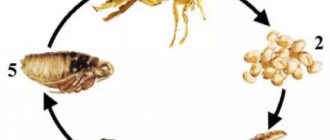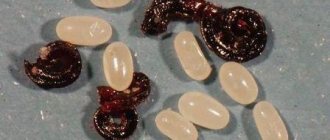Types of vaccines
There are three types of tick vaccinations for dogs, but they all work on the same principle. Each drug contains a small amount of pathogenic intracellular organisms. Name of tick vaccines:
- Nobivac Piro
- Eurican Piro
- Pirodog.
The dog’s immune system fights pathogenic microorganisms that have entered the blood from drugs, producing antibodies to them.
Nobivac Piro
Vaccination for dogs against ticks is produced in the Netherlands by Intervet. The drug contains grafted strains of Babesia A and Babesia rossi. Helps strengthen the body's immune response against the activity of intracellular parasites.
The Nobivak tick vaccination is given to adult animals and puppies over 5 months old. Cannot be used in combination with other vaccines within 2 weeks before and after immunization.
Eurikan Piro
Vaccination against tick-borne encephalitis for dogs in the form of a solution containing red blood cells infected with Babesia canis and treated with gamma rays.
It is these microorganisms that cause canine piroplasmosis, also known as babesiosis. The drug is produced by the French company Merial. It is harmless and, as a rule, does not cause severe side effects.
The development of immunity in animals to pathogens occurs 2 weeks after vaccination. The immune effect lasts for six months.
The dog is vaccinated against encephalitis twice, with an interval of 3-4 weeks.
In rare cases, after taking the drug, pets may experience lethargy and decreased appetite. Such symptoms resolve on their own and do not require therapeutic intervention.
If an allergic reaction occurs, treatment is carried out with antihistamines.
The vaccination is not used against tick bites and does not have a therapeutic effect.
Eurican is allowed to be used with vaccines against rabies and leptospirosis, but only if the injections are administered separately and in different areas of the body.
Pirodog
The vaccine is an analogue of Eurikan Piro, which is also produced by Merial. It has similar composition, indications and side effects.
Can be used without observing the recommended time intervals with vaccinations against leptospirosis and rabies from the same manufacturer.
What is the danger of piroplasmosis for dogs?
Canine pyroplasmosis (babesiosis) is a seasonal parasitic blood disease. The disease occurs as a result of the bite of an infected tick. If you suspect that an animal has been affected by it, you should pay attention to the following symptoms:
- change in the dog’s activity (lethargy, weakness);
- increased body temperature;
- change in urine color (darkening to dark brown);
- the appearance of jaundice.
It must be remembered that without proper treatment, animals are doomed to death. Dogs become infected with the pathogen from the bite of a forest tick. This parasite can change three hosts throughout its life cycle. “Hungry” individuals are recognized by color (yellow, yellow-brown, brown-brown). Having found a host and fed on his blood, the tick turns yellow-pink or gray.
Forest ticks are carriers of dangerous diseases
Tick attacks begin during the onset of the first warmth after winter (almost with the melting of snow). Their activity peaks in mid-May and late August, sometimes at the beginning of September. During a bite, a microorganism (the causative agent of piroplasmosis) enters the dog’s blood, which multiplies in the red blood cells of the host animal. The infection period can last from a couple of days to three weeks. The disease occurs with many severe complications associated with different body systems:
- renal failure;
- liver inflammation;
- heart failure;
- anemia.
Only a veterinarian can diagnose piroplasmosis by carefully examining the pet. The main factor for quickly obtaining an appropriate medical opinion is the report of the removal of a tick (one or several) from the dog’s body after a recent walk. An important indicator is the results of urine tests (attention is paid to such features as color, presence and level of hemoglobin, urobilinogen, bilirubin). Parasites can be detected with a special blood test.
Features of treatment of the disease
Piroplasmosis is very difficult to treat. Medicines suitable for use during illness in most cases lead to undesirable effects. The weakened animal’s body has to withstand a double blow: from the waste products of the parasite in the body and from the chemical effects of medications.
What is the procedure for treating piroplasmosis? Firstly, special medications are prescribed that will destroy the infectious agents. Secondly, measures are taken to eliminate the consequences of the harmful activity of the parasite in the body of a sick dog. The selection of optimal auxiliary therapy takes into account the general clinical condition of the injured pet. Veterinarians often use alkalizing diuresis (a procedure necessary to eliminate complications of the disease). After this, specialists prescribe treatment for emerging concomitant ailments.
In advanced cases, elimination of complications of piroplasmosis is delayed and does not always lead to recovery of the pet
A relatively new and effective treatment method is to cleanse the dog’s blood of toxins, damaged proteins and broken red blood cells through filtration (plasmapheresis, hemosorption).
Preparatory measures
Before vaccinating a dog against ticks, anthelmintic measures are carried out 2 weeks before the intended procedure. It is also necessary to carry out treatment against entomoses in the presence of fleas, lice and any other ectoparasites in the animal.
Before vaccination, the pet must be examined by a veterinarian. It is also recommended to take a blood test to eliminate the risk of inflammatory processes and Babesia microorganisms in the animal.
The best drugs for vaccinations
Today, veterinary medicine most often uses two prophylactic drugs that help fight infections carried by ticks. These medications have different effects on the body, but in both cases the pet begins to produce antibodies that can resist pathogenic bacteria. We are talking about the following vaccines:
- Pirodog (manufactured by Merial), which is blood cells infected with the Babesia canis strain, which are necessarily treated with gamma radiation. This drug includes 2 antigens Ag and RPA (parasitic antigens of a soluble type), which remove the tone from the vascular walls and create a powerful immune complex against the pathogenic pathogen.
- Nobivac-Piro (Intervet) differs from the previous drug in that it is a bivalent type vaccine, designed to combat two main strains that provoke the development of piroplasmosis in domestic animals. Like Pirodog, this drug contains two types of antigens that do not kill pathogenic bacteria, but only reduce their activity, thereby easing the general condition of the pet during infection and significantly accelerating the recovery process.
Both drugs are effective for 12 months, subject to proper vaccination, and this has a certain advantage, because the dog receives reliable protection throughout the year. And if you consider that recently cases of infection of animals have become more frequent even in the cold season, then such prevention is indeed very important.
special instructions
Vaccination against tick-borne encephalitis in animals is carried out only in a veterinary clinic. After the procedure, it is recommended to stay in the hospital for another 20-25 minutes to observe the body’s reaction to the injected drug.
If the pet feels well, then the owner can safely go home with him.
Within 3 days after the tick vaccination has been given, the animal must be given antihistamines prescribed by the doctor.
The pet needs proper rest and nutrition in the first days after the vaccine. It is also important not to overload him with physical activity.
You cannot vaccinate with several types of vaccinations at once, except for those allowed in the instructions for use of the drug. It is recommended to maintain an interval between preventive injections of 3-4 weeks.
When should you start preparing for tick season?
According to the veterinarian, you need to start actively preparing for the spring season while there is still snow - when it melts, all the pathogens are activated.
“The main problem in dogs is piroplasmosis, which is carried by ixodid ticks. The animal is very seriously ill, and if help is not provided in time, it dies. Because of this disease, the dog’s liver and kidneys suffer greatly, and if help is not provided in time, especially if the animal is elderly, the outcome can be fatal,” the expert adds.
Pros and cons of serum
In vaccinated dogs, the consequences of tick bites are much milder or completely asymptomatic. In addition, the vaccine helps prevent the severe consequences of babesiosis (encephalitis).
There are also disadvantages to such vaccinations. Some experts question their effectiveness, since the immune system plays a secondary role when infected with piroplasmosis. The protective functions of the body in this case help reduce the dangerous effects of toxins released by blood parasites.
Among other disadvantages is the high price of drugs. Vaccinating a dog against ticks costs on average 2,500 rubles, excluding the injection by a veterinarian.
Despite this, some experts argue that vaccination is necessary because it reduces the risk of developing encephalitis. Vaccinations are especially necessary for animals living in unfavorable areas where there is a high risk of contracting babesiosis.
Drops on the withers
Some products also kill fleas, but not all, so read the label carefully. Frontline and Advantage are popular brands. Active ingredients include permethrin, imidacloprid, pyrethrin or fipronil.
Some dogs may experience side effects with this treatment, and many dog owners worry that these medications are toxic and could harm their dogs. If you have these fears, talk to your veterinarian about alternatives that have fewer side effects.
Cost of injections
Regarding the cost, all three types of vaccines belong to the same price category. But it is worth considering that two injections are required, which means 2 doses are purchased.
Also, do not forget that injections are carried out only in veterinary clinics and independent use is prohibited.
Therefore, the procedure itself will also be paid. So, regarding the price of one dosage, the average cost is about 2,500 rubles. Additionally, an appointment with a veterinarian (primary), which averages 600 rubles, the procedure itself is about 800 rubles, and taking biomaterial for analysis is 400 rubles.
Reviews from veterinarians
If you study the reviews of veterinarians, you can make sure that vaccination is still recommended and there are more advantages than disadvantages. Of course, you should always remember about other protective equipment, which are no less important.
During the period when ticks are active, be sure to use sprays, drops, tablets, and collars that will provide protection for your pet and minimize the likelihood of an attack. These vaccinations are especially recommended for those animals that live in areas with an increased risk of infection.
Side effects
Like any other injection given to a dog, it can cause swelling in the injection area, there is nothing dangerous or terrible about it, such swelling goes away on its own.
Each organism tolerates the drug individually, and each person may have their own symptoms. Some dogs may experience a slight increase in temperature, which is also a normal symptom.
But an allergic reaction for a dog is dangerous, since the development of anaphylactic shock is observed, in which case veterinary care and mandatory treatment are mandatory.










